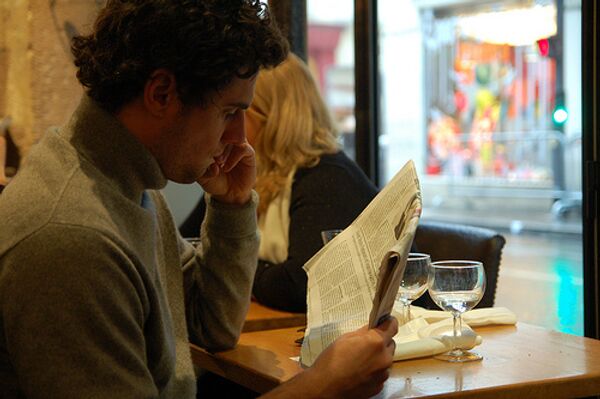Vedomosti
Russian Popular Front to Be Relaunched After October Gubernatorial Elections
Russia’s National Popular Front will not be relaunched until after the October gubernatorial elections: a premature kick-off could spoil the results for the pro-Kremlin United Russia party. The Front’s future will depend on the party’s popularity ratings.
The Popular Front, a public movement initiated by Vladimir Putin in 2011, will be put on the back burner until October. Earlier plans called for an “upgrade” early this fall, with the Justice Ministry registering it as a national public movement. It was to be expanded to include new faces and fresh ideas, and approve Putin as its leader at a convention.
Vyacheslav Lysakov, who was appointed the Front’s chief of staff in June, said he was tasked with preparing the association for official registration – i.e. opening the required number of branches (at least 42).
This week Lysakov said he was only visiting regional coordination councils to discuss the planned reorganization. Although Popular Front candidates are on United Russia’s election tickets in all regions, the Front itself is not involved in any campaigning and apparently has no plans to be.
Its regional branches, which are still housed inside the regional reception offices of United Russia’s leader (now Dmitry Medvedev), are unlikely to be formalized until November, Lysakov admitted.
There are two reasons behind the delay: first, the Popular Front cannot effectively join the election campaign until fully reorganized, and second, they do not want it to detract from United Russia’s success.
Campaign strategists believe that Putin’s move to head a different organization amid the election campaign would dramatically reduce United Russia’s popularity, as its very status as a “ruling” party would come into question, a high-ranking party source said.
There was confusion in Ryazan as Igor Morozov from the Patriots of Russia party (part of the Front) announced he was running for governor with the support of the Popular Front and its leader Putin. Lysakov had to fly to Ryazan to explain that the incumbent governor, United Russia’s Oleg Kovalyov, was seeking reelection, and it is him that the Popular Front and Putin are going to support.
The Popular Front is an umbrella for and generator of organizations targeting social groups which are not covered by United Russia proper, explained Dmitry Orlov, coordinator of the People’s Club – the Popular Front’s expert think tank. Those organizations could play a support role or could be developed into fully-fledged political projects if United Russia’s ratings fall too low. It depends on how well Medvedev’s government copes with new economic challenges.
A source at the Presidential Executive Office said the current popularity rating of 40%-41% is enough for United Russia to collect 50%-53% of the vote, allowing it to remain the majority party. The party will probably face the fiercest opposition in Ryazan, Tver, Udmurtia and Kuban.
Kommersant
Back to Kyoto: Russia Backtracks on Carbon Agreement
Russia’s authorities no longer consider their climate policy to be a completely internal matter, says Kommersant. Prompted by business, officials decided that Russia would participate in the second round of the Kyoto Protocol. The final negotiating position is to be drafted in time for the next round of negotiations in December 2012 in Doha. However, the authorities and business have so far failed to agree on the basic issues: what should Russia’s carbon emission reduction goal by 2020 be and are domestic Russian regulations and markets needed to achieve it?
Until July 2012, the official position on Russia’s participation in the second round of the Kyoto Protocol was straightforward: an international agreement without the participation of the major polluters, including China, the United States, Brazil, India and Japan, is environmentally meaningless. Instead, Alexander Bedritsky, presidential adviser on climate, suggested that a “national and internationally non-binding commitment on carbon emissions by 2020 be worked out and a plan of action for its implementation to be drawn up.”
It seemed the official decision not to participate was a firm one. Even Vladimir Putin was skeptical about “quota trade.” “We have to… develop, not trade in quotas,” he said.
Meanwhile, the summer meetings of the inter-departmental working group of the Economic Development Ministry (which includes also Russian business associations such as Delovaya Rossiya, the Russian Union of Industrialists and Entrepreneurs, and the Chamber of Commerce and Industry) did not limit their discussions to Bedritsky’s proposal. Company applications during the first Kyoto period already exceeded the government-approved quota of 300 million metric tons, and companies were continuing to plan contracts until 2020.
Businesses managed to persuade officials that extra investments were needed – despite falling prices, the EU market has already brought Russia 1.5 billion euros in profits.
“The commitments of the second round of the Kyoto Protocol are in the interests of Russia and Russian business, and will allow Russia to participate in shaping a global international agreement,” believes Yury Fyodorov, co-chairman of the Delovaya Rossiya working group.
The Ministry of the Economy drafted amendments to the resolution regulating this market and sent it to the ministries for approval. The Ministry of Natural Resources and Environment also approved Russia’s participation in the second round.
Meanwhile, Russia’s ultimate goal for the second round (Dmitry Medvedev mentioned a 25% reduction) and whether it will be backed by internal legislation and a plan of action, is still undecided. In July, the Ministry of Natural Resources indicated the goal should be 20%. But the draft was not approved.
Following a reminder from the Kremlin, the Ministry of Natural Resources drafted an executive order where the target is the same – 20%, but there is no concrete action plan.
“The objective announced by the prime minister to cut emissions of greenhouse gases by 25% by 2020 is absolutely normal and will not threaten Russian businesses until at least 2020, and it should be complied with,” Fyodorov added. The 25% goal is also championed by the Foreign Ministry.
RIA Novosti is not responsible for the content of outside sources.



